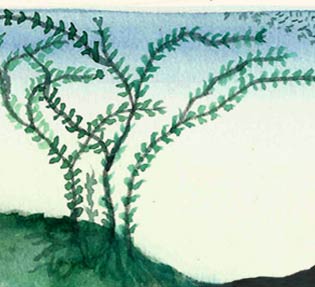
-
Products
Products
-
Services
Services
-
Identify Weeds
Identify Weeds
- Fountains and Aeration
- FAQ
- Contact Us

This group of plants is generally rooted into the bottom sediment and in most cases make up the majority of nuisance conditions that interfere with human activities. Submerged plants have different growth characteristics, some grow near the bottom, and second tier plants can fill up the water column to the mid depths while others reach to the waters surface.
Several common types found in the United States are Coontail – Milfoil – Elodea - Sago Pondweed – Southern and Common Naiad – Exotic species are becoming ever more present like Eurasian watermilfoil – Curly-leaf Pondweed and Hydrilla just to name a few.
Identify the plant problem; choose the recommended solution. We are always here to help. Midwest Aqua Care, Inc. Since 1979
Wild Celery

Wild Celery, also called tape or eel grass. Leaves are ribbon like and dark green. Looks similar to turf grass but grows two to three times larger.
Our #1 Recommendation:
Hydrothol GranularCanada Waterweed

Grows entirely underwater, except for a small white flower that blooms during the summer. Has branched stems, leaves are usually dark green color. Leaves are oval shaped and arranged in clusters of three or four around the stem.
Our #1 Recommendation:
Hydrothol GranularBushy Pondweed-Naiads

Common in the Naiad family is bushy, water, brittle, slender and southern naiad. Bushy pondweed is sometimes confused with chara. Leaves are tapered to a fine point with tiny spines.
Our #1 Recommendation:
Hydrothol GranularEurasian Watermilfoil

Unfortunately this exotic plant is established in most states. It grows densely forming surface mats that prohibit recreation and displace desirable native plants communities.
Our #1 Recommendation:
Sculpin 40 lbs bag (Navigate Granular alternative)Northern Watermilfoil

Occurs throughout North America. Stem is hollow with whorled leaves along entire length of plant. Pairs of leaflets will not exceed ten. See also Eurasian watermilfoil. Navigate herbicide is the best choice to control this weed.
Our #1 Recommendation:
Hydrothol GranularCurly-Leaf Pondweed

Curly-leaf pondweed is an exotic plant. Usually the first to appear in early spring. Key Identifiers: Leaf veins are clearly visible - wavy (scalloped) outer leaf edges.
Our #1 Recommendation:
Aquathol Super KCoontail

Coontail gets its name from its resemblance to the tail of a raccoon. Lacking true roots this plant can also be found floating. Differentiated from milfoils by forked, not feathery leaves.
Our #1 Recommendation:
Hydrothol GranularLargeleaf Pondweed

Largeleaf Pondweed has thick, large stems. There broad leaves appear wavy and taper toward the stem. There are many types of large leaf pondweeds, a challenge to control.
Our #1 Recommendation:
Aquathol Super KSago Pondweed

Sago Pondweed is bushy in appearance with thread like leaves growing one to six inches long. A spreading of the leaves in the water resembles a fan.
Our #1 Recommendation:
Hydrothol GranularAmerican Pondweed

American Pondweed has submersed and floating leaves that are oval shaped. There are several other similar plants with floating leaves like Illinois, Floating and Waterthread Pondweeds. These plants are common and widespread throughout the United States.
Our #1 Recommendation:
Hydrothol GranularWater Stargrass

Water Stargrass has long stems and leaves that are grass like in appearance. The flower is small, yellow and star-shaped. Water Stargrass is found throughout the United States.
Our #1 Recommendation:
Hydrothol GranularWater Hyacinth

Water Hyacinth is a real problem in the Southern United States. The plants are free floating, sometimes attached in mud. Plant height in variable from a few inches to three feet. The flower can be blue, violet or white.
Our #1 Recommendation:
AquaMasterHydrilla

Hydrilla is an exotic plant that easily grows to the surface and forms dense mats. The stems are long and branched. The leaves grow in whorls of four to eight. Looks very similar to Brazilian Elodea.
Our #1 Recommendation:
Reward HerbicideAmerican Elodea

American Elodea is common in the Northern and North Central states south to Kentucky and Virginia. Elodea can grow into dense populations that reach to or near the surface easily prohibiting recreational water use.
Our #1 Recommendation:
Hydrothol Granular